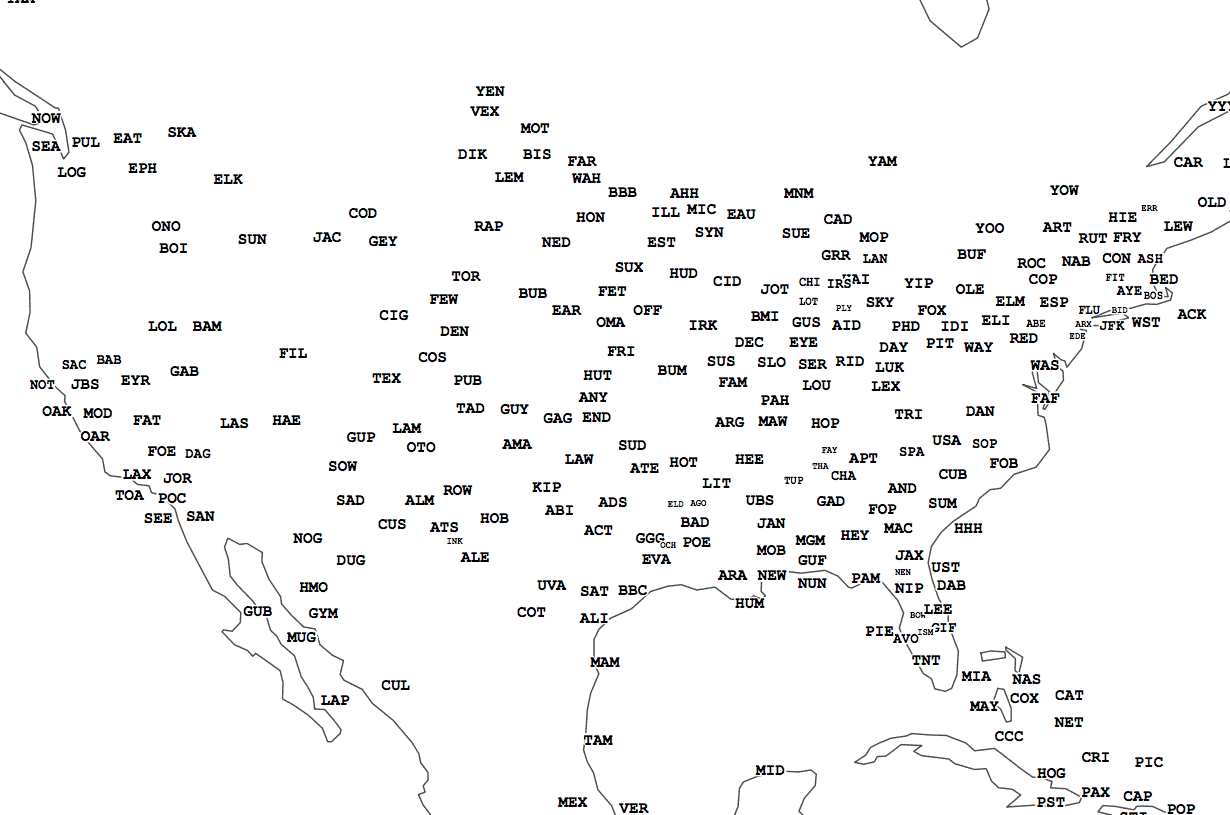What’s In an Airport Code? Poetry, It Turns Out
Share

APEX Insight: How doth thee love airport codes? Let us count the ways.
Slated for release this October, Nasser Hussain’s second poetry collection SKY WRI TEI NGS pushes the envelope on aeronautical expression with poems composed entirely out of airport codes. Much more than odes to the three-letter IATA codes, the collection’s poems assume various forms and styles, and cover a range of themes, from air travel to Gamergate and Islamophobia. Illustrations by Matthew Stephenson map out the poetic flight paths of poems and help to visualize Hussain’s exploration of the relationship between place and language.
“I like this project because airport codes work as both language and geography simultaneously,” Hussain told APEX Media. “And as a poet, I’m always attracted to words that can say two (or more) things at once.” The poem “AIR TRA VEL,” for instance, spells out the word MIG RAT ION and plots a journey from Mianyang in China, to Raduzhny in Russia, to Impfondo in the Republic of Congo.

Jet-set logophiles may already be familiar with the geographical poetry created by certain itineraries. Traveling Frankfurt to Nice, for example, very accurately brings you to FRA-NCE. To plot Amsterdam across the sky, one starts recursively in Amsterdam (AMS) then heads to Lajes Airport (TER) in Azores and finishes in Damascus (DAM). Flying the route TRI-ANG-LED will create an actual triangle, though it is a rather obtuse one.
A ticket to SIN’s city will land you on the other side of the Pacific, almost 9,000 miles from Sin City. You can go to HEL figuratively, or literally if traveling to Helsinki. Or, those with a death wish may buy a ticket to DIE – Arrachart airport in Madagascar, that is.

Fittingly, the idea for SKY WRI TEI NGS occurred to Hussain, a lecturer in Literature and Creative Writing at Leeds Beckett University, during a flight. “It all started one winter when, on a return flight from Canada to the United Kingdom, I noticed that the IATA code for Manchester International Airport is MAN,” he explained. The observation led him to wonder how many other airport codes could be counted as words and strung into coherent sentences.
Based on Hussain’s research, which involved pouring over databases and dictionaries, there are 1,050 – though he cautions that it’s not a definitive list. For example, he elected to include proper names like EVA, BOB, or ANU (an ancient Babylonian sky god), and in some cases words in other languages. Add six, nine, and 12-letter words into the mix, and the number of eligible airports grows. Some poems also play with the sounds of codes. For example, in “KITTEN HOK,” which transposes the first sentence of Wilbur and Orville Wright’s The Early History of the Airplane, the word “generally” is spelled: JIN ERR ALL AEI.
On an unrelated but parallel quest to map out airport-code words, artist Parker Higgins wrote a Python script to cross-reference code combinations with dictionary entries. His search yielded 106 nine-letter words formed from airport codes. By best count, the longest words that can be spelled in airport code are 15-letter acetylsalicylic and substratosphere, which, in the case of the latter, is somewhat ironic since its itinerary would have you in the stratosphere for 20,516 miles.
As far as I can tell, the longest words you can spell entirely out of airport codes are each 9 letters long. It's quite an evocative list of words, too. pic.twitter.com/ssNMRz3s5O
— Parker Higgins (@xor) March 28, 2018
Over the years, airlines, airports and travel agencies have also dabbled in a bit of airport word play of their own. Ogilvy & Mather’s award-winning ads for Expedia in 2013 arranged bag tags in 36 combinations to create phrases like WSH EWE WRE ERE and SUN SEA SND SEX. KLM used Southampton’s SOU code for a #Soclose2U awareness campaign intended to let residents know the airline operates regular flights from the UK city to Amsterdam.
A good code and tagline can help to boost tourism. Jerusalem’s mayor has proposed changing Israel’s international airport code from TLV for Tel Aviv to JLM for that purpose. But IATA identifiers are notoriously difficult to alter. Just ask Sioux City officials, who after several years of unsuccessfully petitioning for a new one, finally embraced its code with a “Fly SUX” slogan.
St. Pete-Clearwater International Airport’s tagline appetizingly encourages travelers to “Fly to PIE.” Other airports such as OMG, LOL and FUN are readymade for punning. Fukuoka, Bolshoye Savino and Poco De Caldas airports, on the other hand, should probably steer clear of that territory.
Most avgeeks have their favorite airport codes. “NAS is in the Bahamas, and I’d really like to go there someday,” says Hussain, whose first name starts with the same three letters. But writing the collection also gave him a new appreciation for a couple of unassuming airports. “Honestly, if it wasn’t for Senador Petrônio Portela Airport (THE), and Anderson Regional (AND), this book wouldn’t have been possible…so I’m going to have to say they’re my favorites!”


